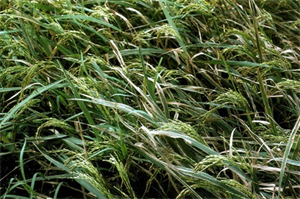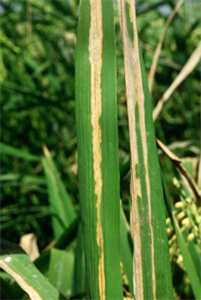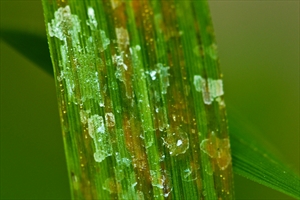Rice bacterial leaf blight; also known as rice leaf blight.
Pacific Pests, Pathogens, Weeds & Pesticides - Online edition
Pacific Pests, Pathogens, Weeds & Pesticides
Rice bacterial leaf blight (418)
Xanthomonas oryzae pv. oryzae. Different strains exist in Japan and the Philippines and, importantly, differences exist between strains in Asia and Africa.
Asia, Africa, North, South, and Central America, Europe, Oceania. It is recorded from Australia, and Fiji.
Rice and wild grasses, especially rice cutgrass (Leersia species), which occur worldwide.
Bacteria enter the plant through natural openings and wounds, move in the xylem, the water-conducting system of the plant, and block them (Photo 1).
On seedlings, leaves show grey-green streaks starting from the tips and at the margins; later the streaks join together, turn yellowish-white with wavy edges, and the leaves wilt, dry up and die. On transplanted rice, early infection may be systemic, i.e., throughout the entire plant, and cause similar symptoms, known as ‘kresek’, an Indonesian word. On older plants, the leaves show pale yellow steaks with wavy margins going from the tips towards the base, dry up and die (Photo 2).
Later infection, at booting stage, does not affect yield, but results in poor quality of rice.
Small milky drops of liquid (containing bacteria) ooze from the streaks, later drying as a crust on the leaves (Photos 3&4). Streaks also occur on the leaf sheaths and the stems of susceptible varieties.
Spread within the crop occurs in irrigation and floodwater, and in wind-driven rain. Over longer distances spread is probably via seed. In general, temperatures of 25-34°C and relative humidity over 70% favour the disease.
Survival of bacterial leaf blight between crops is not well understood. It probably occurs in seed. The bacteria do not last long in the soil, or in plant remains after harvest - about a month under dryland conditions and perhaps half as long when submerged. Longer survival is on weeds.
Bacterial leaf blight can be devastating if it comes early. Yield losses range from 20% to more than 70% in Southeast Asia and India. In the Philippines, yield losses on susceptible varieties may reach more than 20% in the wet season, 7% in the dry. In Africa, it was first reported in the 1970s, but only more recently has it become a serious disease, particularly of irrigated rice in the Sahel. There have been regular epidemics since 2002 in a number of countries. For instance, in Niger, losses in irrigated areas in 2013 range from 19 to 63%, estimated to cost US$400-1000/ha). Mali, too, is recording epidemics.
Look for leaf streaks, and check that the margins are wavy - there is another disease, Xanthosomas oryzae pv. oryzicola, where the margins are straight. Look for bacteria in the leaves: cut a leaf across a young streak and place the cut end in a glass of water: if bacteria are present a cloudy liquid will stream out. Note, symptoms can be similar to damage by stem borers. Check if yellowish liquid oozes from the ends of cut leaves, and whether the stems can be easily pulled out (see Fact Sheets nos. 408-412).
BIOSECURITY
National biosecurity organisations need to ensure that rice seed entering the country originates from crops certified free of bacterial leaf blight and is subject to closed quarantine upon arrival, and further testing for the bacterium causing this disease. Note there are different strains in different parts of the world.
CULTURAL CONTROL
In low-input farming systems, where resource-limited farmers can hardly ever afford external inputs, control of bacterial leaf blight is mainly through the use of resistant/tolerant varieties in combination with sound management practices, such as good weed control.
Before planting:
-
Take care when selecting seed. For farmers who are using their own seed, it is important that they always select from plants uninfected by bacterial leaf blight symptoms.
During growth:
-
Do not damage seedlings when taking them from the nursery. They should not be pulled from the soil but eased out with roots intact; the leaves should not be clipped.
-
Be careful with fertilizer applications: too much nitrogen increases shoot and leaf production and creates conditions that promotes disease development because of higher humidity. A suggested amount is 80-100 kg N/ha, depending on local conditions.
-
Ensure good drainage of fields (and nurseries). Most varieties are not able to withstand flooding for more than a week, and floodwater spreads the bacterial leaf blight between plants.
-
Keep field clean of weeds, especially species of Leersia which are considered to be the main weed host of bacterial leaf blight.
After harvest:
-
Plough land to bury rice stubble, straw, ratoon plants and volunteer seedlings. Note that the bacteria causing this disease do not live long in the soil.
-
Allow fallow fields to dry to destroy the bacterium in the soil and in plant remains.
RESISTANT VARIETIES
Resistant varieties are available in Southeast Asia: PSB Rc82 is a standard variety with resistance; Macassane, has been shown to have improved bacterial leaf blight resistance and is being used in Mozambique, and two IRRI varieties, IR22 and IR 54, are resistant and moderately resistant, respectively, in Tanzania. Several NERICA hybrids from AfricaRice have been tested and found to have resistance. Check whether these are available locally.
CHEMICAL CONTROL
Chemical treatments, such as applications of copper compounds or antibiotics, are costly and have NOT been shown to be effective.
AUTHOR Grahame Jackson
Information from CABI (undated) Rice leaf blight (Xanthomonas oryzae pv. oryzae). Plantwise Knowledge Bank. (http://www.plantwise.org/KnowledgeBank/Datasheet.aspx?dsid=56956); and CABI (2018) Xanthomonas oryzae pv. oryzae (rice leaf blight). Crop Protection Compendium. (https://www.cabi.org/cpc/datasheet/56956); and Bacterial blight (various articles). Rice Knowledge Bank. IRRI. (http://www.knowledgebank.irri.org/search-results?gsquery=bacterial+leaf+blight); and from Xanthomonas oryzae pv. oryzae. Wikipedia. (http://en.wikipedia.org/wiki/Xanthomonas_oryzae_pv._oryzae). Photo 1 Chin Khoon, CABI. Photo 2-4 Rice Knowledge Bank. IRRI. (http://www.knowledgebank.irri.org/decision-tools/rice-doctor/rice-doctor-fact-sheets/item/bacterial-blight).
Produced with support from the Australian Centre for International Agricultural Research under project HORT/2016/185: Responding to emerging pest and disease threats to horticulture in the Pacific islands, implemented by the University of Queensland and the Secretariat of the Pacific Community.







